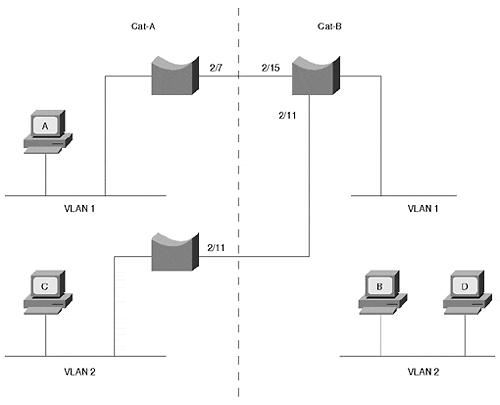Answers to Chapter 5 Review Questions
1:
Early in this chapter, it was mentioned that you can determine the extent of a broadcast domain in a switched network without configuration files. How do you do it?
A:You can use a brute force approach where you systematically attach a traffic source on a port on a switch configured to generate broadcasts. With a network analyzer, you then check every port in the system to observe where the broadcast appeared. Every port where the broadcast is seen is a member of the same VLAN as the source. Then, you can move the source to a port not mapped in the first step and repeat the process until all ports are mapped.
2:Two Catalysts interconnect stations as shown in Figure 5-22. Station A cannot communicate with Station B. Why not? Example 5-8 provides additional information for the system.
A:Although Station A and B addresses belong to the same logical network, A and B attach to different VLANs. This makes it very difficult for them to talk to each other. Layer 2 switches do not forward traffic between VLANs, and no router exists in the system to interconnect the VLANs. Therefore, they cannot communicate with each other.
3:Again referring to Figure 5-22 and Example 5-8, can Station C communicate with Station D?
A:No. Although Stations C and D belong to the same logical network and the same VLAN, there is no connectivity between the switches for VLAN 2. Note that, on Cat-A, one inter-switch port belongs to VLAN 1 and the other to VLAN 2. But for Cat-B, neither of the inter-switch ports belong to VLAN 2. This prevents any VLAN 2 traffic from passing between the Catalysts.
4:Are there any Spanning Tree issues in Figure 5-22?
A:There are no loops in the network, but VLANs 1 and 2 in Cat-A are merged into one broadcast domain through the VLAN 1 virtual bridge in Cat-B. See Chapters 6 and 7 for a discussion of Spanning Tree.
5:Draw a logical representation of Figure 5-22 of the way the network actually exists as opposed to what was probably intended.
A:Figure A-4 presents a logical representation of the network in Figure 5-22.
Figure A-4. Logical Representation of the Network in Figure 5-22

Is there ever a time when you would bridge between VLANs?
A:You might need to enable bridging between VLANs on a router whenever you have non-routable protocols such as LAT or NetBeui. In this case, you need to route all other protocols and bridge only the nonroutable protocols. Be careful of Spanning Tree topology issues though, because the router participates in Spanning Tree along with the Catalysts.
7:List the three components of dynamic VLANs using VMPS.
A:A Catalyst system using VMPS has the following components:
VMPS server
VMPS client
TFTP server with a configuration text file.
EAN: N/A
Pages: 223
- The Effects of an Enterprise Resource Planning System (ERP) Implementation on Job Characteristics – A Study using the Hackman and Oldham Job Characteristics Model
- Context Management of ERP Processes in Virtual Communities
- Distributed Data Warehouse for Geo-spatial Services
- Healthcare Information: From Administrative to Practice Databases
- A Hybrid Clustering Technique to Improve Patient Data Quality